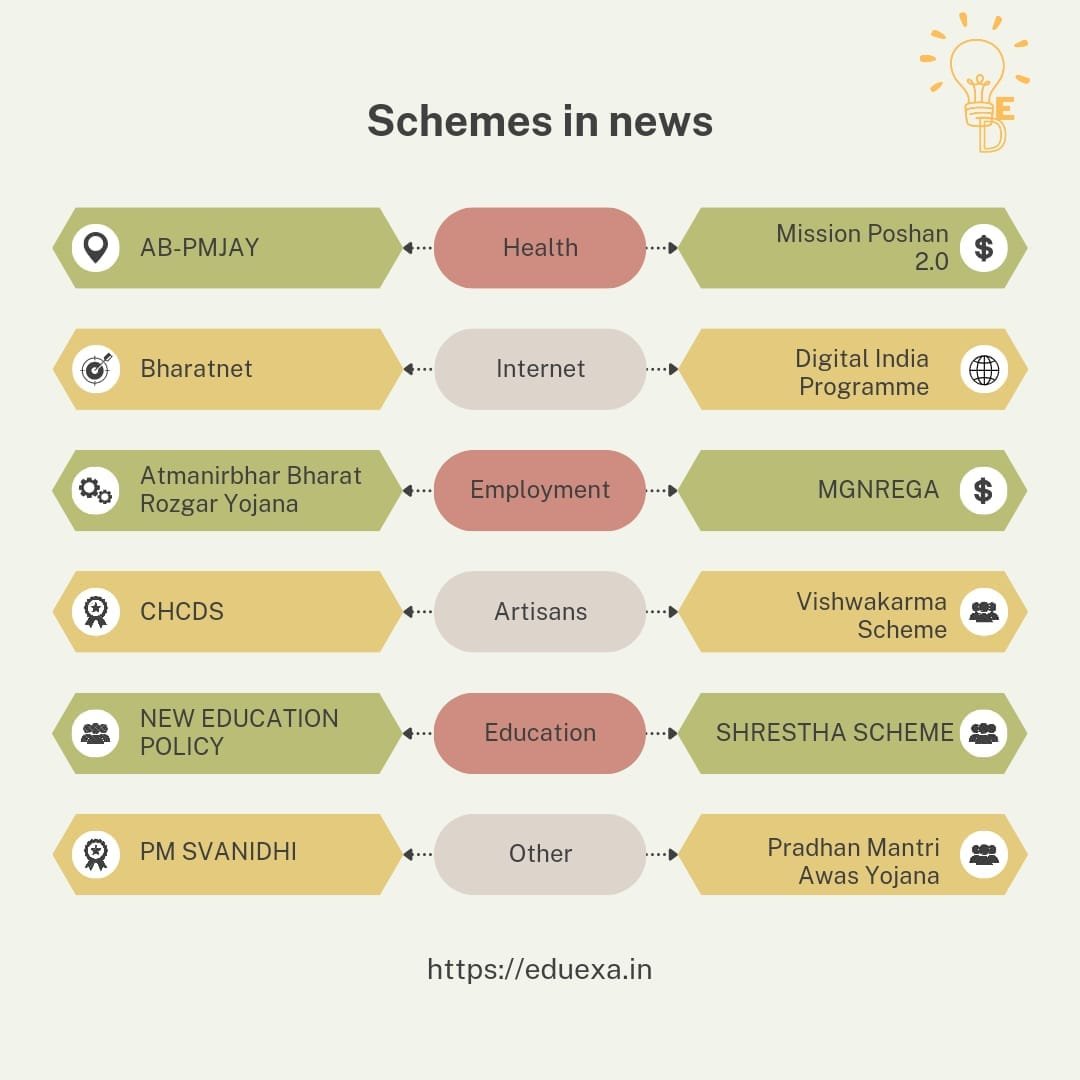Schemes in News 2024 | Schemes for UPSC | Government Schemes
Ayushman Bharat Scheme
Type – Centrally sponsored scheme under ministry of health and family welfare
Purpose – To achieve universal health coverage
About the scheme-
- Ayushman Bharat is a health Scheme of centre to holistically address the health care system at all three levels i.e. primary, secondary and tertiary level
- PMJAY and creation of health and wellness centres are two interrelated components of Ayushman Bharat.
- Rs 5 lakhs per family per year for secondary and tertiary care hospitalisation would be taken care of.
- Coverage of 3 days of pre-hospitalisation and 15 days of post-hospitalisation expenses including medicines and follow up consultation and diagnosis.
Read species in news here.
Digital India Programme
Type – It is an umbrella program launched in 2015 implemented under overall coordination of the ministry of electronics and Information Technology.
Objectives:-
To transform India into a digitally empowered society and knowledge economy.
To ensure digital access, digital inclusion, digital empowerment and bridge the digital divide.
To ensure that Government services are available to citizens electronically.
Vision :- Vision is centred around 3 key areas
→ Digital Infrastructure as utility to every citizen
→ Governance and services on demand
→ Digital empowerment of citizens
Atmanirbhar Bharat Rozgar Yojana
Implementing agency- EPFO
Objectives
- To incentivize employers for the creation of new employment along with social security benefits.
- Restoration of loss of employment during the COVID- 19 pandemic.
- To reduce the financial burden of the employers of various sectors/industries including MSME and to encourage them to hire more workers.
Salient features
It is being implemented through the Employees Provident Fund Organisation (EPFO).
The benefit shall be available for a period of twenty-four wage months from the date of registration of the new employee by the employer of the eligible establishment.
The number of employees with Universal Account Number (UAN) for whom the employer has remitted EPF/EPS contributions through ECR filed for the wage month of September 2020 up to the due date shall be taken as a reference base of employees.
For establishments employing upto 1000 employees, the Government will pay both 12% of employees and 12% of employers’ contribution of wages towards the Employees Provident Fund (EPF).
For establishments employing more than 1000 employees, the Government will pay only employees’ EPF contribution i.e., 12% of wages in respect of new employees.
An establishment, initially with fewer than 1000 employees in September 2020 ECR, will still receive employer’s share support, even if the EPF members with UAN exceed 1000 in any month during the scheme.
Any eligible new employee under this Scheme shall become ineligible if his/her monthly wage exceeds 14999/- at any point of time during this scheme period.
If any new employee is already a registered beneficiary under Pradhan Mantri Rojgar Protsahan Yojana (PMRPY) / Pradhan Mantri Paridhan Rojgar Protsahan Yojana (PMPRPY), no benefit in respect of such new employee shall be available under ABRY.
Pradhan Mantri Awas Yojana (PMAY-Urban)
Type– Only CLSS is Central Sector Scheme, remaining is Centrally sponsored scheme under Ministry of housing and urban affairs.
Objective – Provide all weather pucca houses to all eligible beneficiaries in urban areas through nodal agencies.
Components –
- In-situ Slum Redevelopment (ISSR) : Central Assistance of Rs 1 lakh per house is admissible for all houses built for eligible slum dwellers, using land as a resource with the participation of private developers.
- Credit Linked Subsidy Scheme (CLSS): Benefit of up to 2.67 lakh per house through Interest Subsidy of 6:5%, 4% and 3% on loan amounts up to Rs. 6 lakhs, Rs. 9 lakhs and Rs. 12 lakhs.
- Affordable Housing in Partnership (AHP): Central Assistance of Rs.1.5 Lakh per EWS house is provided by the Government of India in projects where at least 35% of houses in projects are for the EWS category and a single project has at least 250 houses.
- Beneficiary-led Construction/ Enhancement: Central Assistance up to Rs. 1.5 lakh per EWS house is provided to either construct new houses or enhance existing houses on their own.
Features –
- All houses built under this scheme have basic amenities.
- Cafeteria approach to best suit the needs of individuals based on topographic, economic and other factors is adopted.
- Conform the standards provided in National Building Code (NBC).
- Ownership in the name of women or joint name would empower women.
SVAMITVA Scheme (2021)
Type- Central Sector Scheme under Ministry of Panchayati Raj
Objectives– To provide an integrated property validation solution for rural India.
Benefits –
The scheme will help in streamlining planning and revenue collection in rural areas and ensuring clarity on property rights.
The scheme will enable creation of better-quality Gram Panchayat Development Plans (GPDPs), using the maps created under this programme.
The Gram Panchayats are constitutionally mandated for preparation of Gram Panchayat Development Plans (GPDP) for economic development and social justice.
MGNREGA
Type– Centrally Sponsored scheme
Objective – The primary objective of the scheme is to guarantee 100 days of employment in every financial year to adult members of any rural household willing to do public work-related unskilled manual work.
Features –
- The cornerstone of MGNREGA’s design is its legal guarantee, ensuring that any rural adult can request work and must receive it within 15 days.If this commitment is not met, an “unemployment allowance” must be provided.
- It requires that priority shall be given to women in such a way that at least one-third of the beneficiaries shall be women who have registered and requested for work.
- Section 17 of the MGNREGA has mandated Social audit of all Works executed under the MGNREGA.
PM SVANIDHI (Prime Minister Street Vendor’s Atmanirbhar Nidhi) Scheme
Type- Central Sector Scheme under ministry of Housing and Urban Affairs
Implementation partner – SIDBI
Aim– A micro-credit scheme for urban Street Vendors to facilitate street vendors in resuming their livelihood activities which were impacted due to COVID 19.
Benefits –
- Facilitate collateral free working capital loan upto 10,000, of 1 year tenure, with enhanced loan of ₹20,000 and ₹50,000 in the second and third tranches respectively, on repayments of earlier loans.
- Incentivize regular repayment, through interest subsidy @ 7% per annum; and
- Reward digital transactions, by way of cashback upto 1,200 per year.
PM Vishwakarma Scheme
Type- Central Sector Scheme under ministry of MSME
Objective –
To enable recognition of artisans and craftspeople as Vishwakarmas. (18 traditional trades are recognised under it)
To provide incentives for digital transactions to encourage digital empowerment of Vishwakarmas
To provide a platform for brand promotion and market linkages to help them access new opportunities for growth.
Benefits –
- Marketing Support: National Committee for Marketing (NCM) will provide services such as Quality Certification, Branding & Promotion, E-commerce linkage, Trade Fairs advertising, publicity and other marketing activities.
- Cheap credit: Credit support will rejuvenate sector:-
- Collateral free Enterprise Development Loans: Rs 1 lakh (First Tranche for 18 months repayment) & Rs 2 lakh(Second Tranche for 30 months repayment).
- Concessional Rate of Interest: 5% to be charged from the beneficiary with Interest Subvention cap of 8% to be paid by MoMSME.
- Credit Guarantee fees to be borne by Gol.
- Skill Upgradation: Basic Training of 5-7 days and Advanced Training of 15 days or more, with a stipend of Rs. 500 per day.
- Creating a holistic support ecosystem: Provisions such as incentives for Digital Transactions and Marketing Support, liberal loan terms, etc. will help to develop a supporting ecosystem for this industry.
- Incentive for Digital Transaction: Rs 1 per transaction for maximum upto 100 transactions (monthly).
- Preserving Traditions: The scheme encapsulates the essence of preserving heritage while embracing progress.
- Promote Gender justice and social justice: As per the census of crafts conducted during the Seventh Plan period, there were more than 68.8 lakh crafts persons in the country. Women (56.13%) and socially and economically disadvantaged sections like SC, ST and OBC (which together make up more than 72%) account for a majority of the pool.
| 18 Traditional Trades |
| Armourer |
| Boat maker |
| Blacksmith |
| Barber |
| Basket/mat/Broom maker/Coir weaver |
| Cobbler |
| Carpenter |
| Doll and toy maker |
| Fishing Net maker |
| Goldsmith |
| Garland maker |
| Hammer and tool kit maker |
| Locksmith |
| Mason |
| Potter |
| Sculptor, stone breaker |
| Tailor |
| Washerman |
Shreshta Scheme
Type – Central Sector Scheme under Ministry of social justice and empowerment
Objective – To fill the gap in service-deprived SCs dominant areas and provide an environment for socio-economic upliftment of SCs.
Benefits –
- Admission will be provided in Class 9 and Class 11 of CBSE/State affiliated private schools.
- The Department covers the total fee for students, including school and hostel fees, amounting to Rs. 1,00,000 to Rs. 1,35,000 from class 9th to 12th.
- Schools/Hostels run by VOs/NGOs with classes up to 12th grade receive grants for school fees and residential charges for SC students.
SAKSHAM Portal
The Union Health Ministry has introduced the SAKSHAM (Stimulating Advanced Knowledge for Sustainable Health Management), a Learning Management Information System (LMIS) of the Ministry of Health and Family welfare .
SAKSHAM serves as a comprehensive digital learning platform for offering online training and medical education to all healthcare professionals across the country.
Developed By:
National institute of health and family (NIHFW).
Objective:
The platform aims to ensure inclusive capacity building among health professionals, ranging from those working in rural and remote primary health centre to those in metropolitan cities’ tertiary care and corporate hospitals.
Coverage:
Currently, SAKSHAM: LMIS hosts over 200 public health and 100 clinical courses, accessible through online mode.
Prospects:
Saksham will be developed as a centralised resource repository for training and teaching material.
It will also act as a central database of trained healthcare professionals in the country.




Pingback: Coral Reef | Coral Reef UPSC: A Complete Guide in 2024